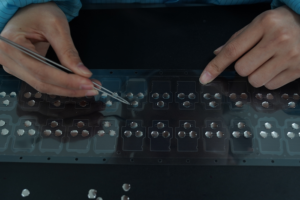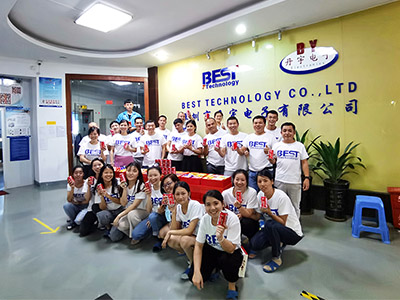For the previous article, please view http://www.metal-domes.com/blog/2006/09/08/stainless-steel-material-of-metal-dome-1Â
4) Families of stainless steels
There are several families of stainless steel: FERRITIC, MARTENSITIC, AUSTENITIC and DUPLEX. These names are derived from the crystal structure of the steels, which governs their metallurgical behaviour.
FERRITIC stainless steels are magnetic, have a low carbon content and contain chromium as the main alloying element, typically between 13% and 17%.They are not hardenable by heat treatment.
MARTENSITIC stainless steels are magnetic, containing typically 12% chromium with a higher carbon content than the ferritic types. They are hardenable by quenching and tempering like plain carbon steels and find their main application in cutlery, aerospace and general engineering.
AUSTENITIC stainless steels are non-magnetic and, in addition to chromium typically around 18%, contain nickel. This enhances their corrosion resistance and modifies the structure from ferritic to austenitic. They are the most widely used group of stainless steels. They are not hardenable by heat treatment.
DUPLEX stainless steels are used where combinations of higher strength and corrosion resistance are needed. They have a mixed structure of austenite and ferrite, hence the term “duplex”. They are not hardenable by heat treatment.
PRECIPITATION HARDENING stainless steels, like the martensitic types, can be strengthened (ie hardened) by heat treatment. The mechanism is metallurgically different to the process in the martensitic types. This means that either martensitic or austenitic precipitation hardening structures can be produced.
“Super” austenitic or “super” duplex grades have enhance pitting and crevice corrosion resistance compared with the ordinary austenitic or duplex types. This is due the further additions of chromium, molybdenum and nitrogen to these grades.
5)Benefits and properties of stainless steels
In economic terms stainless steels can compete with higher cost engineering metals and alloys based on nickel or titanium, whilst offering a range of corrosion resisting properties suitable for a wide range of applications. They have better strength than polymer products such as GRP. Stainless steels can be manipulated and fabricated using a wide range of commonly available engineering techniques and are fully “recyclable” at the end of their useful life.
In addition to their corrosion resistance, stainless steels also offer other useful properties, depending on their “family”.The austenitics, in the fully annealed heat-treated condition, are:
• Fracture tough at cryogenic temperatures
• Para-magnetic with relative magnetic permeabilities around 1.05
The martensitic and precipitation hardening families are hardenable by heat treatment. The duplex stainless steels are stronger than the austenitics in the annealed condition and so can be used in thinner sections to save weight and cost.
The ferritics are lower cost stainless steels.
6) Stainless steel and the environment
The main source of raw material for making stainless steels is re-cycled scrap metal. This re-cycling route has been established for many years and the economics of the stainless steel making industry depend on recycling. Over 90% of new stainless steel is produced from recycled scrap.
The steel is melted electrically and in most cases refined by using inert air distilled gases, such as argon. Great care is taken to minimise fume and dust emissions. Some plants are equipped to re-cycle dust into the steel making process.
Most of the steel processing consumable materials, including cooling water, lubricating oils, pickling acids and “inter-leaving” paper are re-cycled in the plant or by specialist contractors. Stainless steel fabricators and processors re-cycle their scrap arisings and in-process consumables, including “caking” pickling acid residues for re-cycling.
As stainless steels are corrosion resistant alloys their life expectancy is usually long. A minimum of maintenance is needed and so, although more expensive initially, they offer attractive “life-cycle cost” benefits over alternatives such as carbon steels. Stainless steels are easily cleansible and so an obvious choice for food and beverage manufacturing industries and catering equipment. There are no proven health risks from the normal use of stainless steels. The possible risks from alloying elements such as nickel and chromium are under constant review by experts.
 (finished)Â
Not enought? You can let me know your comments or questions, we’re glad to answer your questions.










Pingback: Metal-Dome » Blog Archive » Metal Domes Technology and Parameters
dear sir,
i got your message from webs. we are buyer of 304 Stainless Steel Scrap in China. would you pls offer u quantity and your price for us?
thanks for your response.
yours faithfully,
lin wg/GM
T:0086-13581063917
EMAIL:linwg888@yahoo.com.cn
pls offer u qingdao,china price
Hi Lin,
Thanks for your attention. But we are not the supplier of stainless steel, we make the metal domes and metal dome arrays. If you need to find the material, maybe you’d better hunt elsewhere.
Regards
Peter
Hi Sir
We are a lading europe precision strip manufacturor located in Dortmund, Germany. One of important product we sell to China is 1.4310/301 strip used in metal dome. Now we have stock in our distribution centre Taicang.
Wish we could have chance to cooperate. Due to the waek Euro, we may contribut a lot for cost saving.
Gui
Senior account manager of
ZAPP Taicang
13916661741
Hi all,
Very good information here are posted for metal dome. Please look for http://www.amcometal.net for stainless steel manufacturer contact and more…………
Hi Sandeep,
tks. We will go and see it.
Santhana Lakshmi Metals is one of the largest groups in the field of Non-ferrous metals since two decades.We mainly deal in Stainless Steel,Aluminum,Brass and Copper in the form of Sheets,Pipes,Rods and Flats of different sizes.
Currently we imported the stainless stell from Japan. But anyway, thanks for your message.
Pingback: ?????????? « ????-???-???